Art Department Gallery Brings to Life MFA and BFA Showcases
Art Department Gallery Brings to Life MFA and BFA Showcases
Each spring, the Department of Art and Art History hosts two exhibitions that play a critical role in our students’ graduation experiences. All MFA students are required to participate in an MFA Exhibition. Select work from BFA students is juried into another exhibition of the best work from graduating seniors across art and design. As with all shows in the Elaine L. Jacob and Art Department galleries, Gallery Director Tom Pyrzewski and Gallery Manager and Preparer Laura Makar apply their high standard of exhibition design and gallery management to ensure these showcases have a professional production.
Building the MFA Show
Throughout the academic year, graduating MFA candidates work with their advisors, Graduate Officer Heather Macali, and gallery staff to develop their bodies of work into a successful exhibition. “The whole thing is a collaborative effort.” Pyrzewski emphasizes, explaining that he and Makar take a very hands-on approach to the process. They start by meeting each student in their studio, getting to know their approach and vision, to best advise them on work selection, discuss what is possible, and create an individualized plan for their work. They also meet as a group with the Graduate Officer to discuss specific needs, plans, and key dates. As the plan for the show comes together, the gallery assists with promotional and educational materials such as postcards, vinyl graphics, informative text, and curatorial statements.
Creating a flawless, meaningful installation is critical to the success of the MFA show, and the gallery staff take extra steps to make sure that the students are happy with the results. This requires close collaboration with the exhibiting artists. Pyrzewski explains, “The students have a lot of flexibility but also guidance with the installation. We instruct them on the best way to install but work with them if they have a vision for how they want it to look. We are there to ensure that the artwork is hung and lit professionally. Throughout the process, we are there for them, but when we open the gallery, we literally hand them the key.”
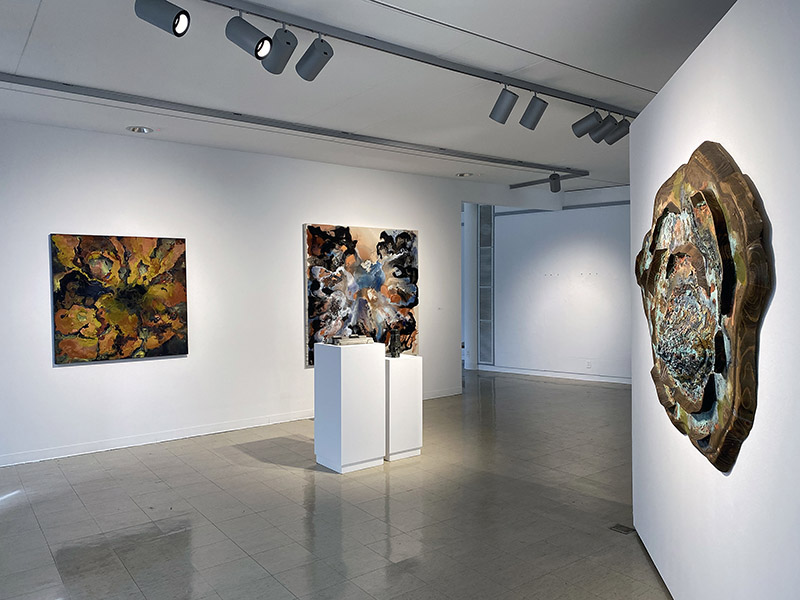
The 2023 MFA show, entitled Aggregrate, showcased the work of Aaron Deshields, Sarah Heuninck, and Ephemera Fae. The title Aggregate developed from the idea that each artist has a understanding of their creative process, and the differences among the individual artists and their work takes on new meaning when viewed together. Deshields is a sculptor and metalworker who explores forging, fabrication, and casting. He explores the effects that energy and pressure can have on materials, concepts of geophysics, and catastrophic releases of energy. Heuninck is a contemporary painter exploring ideas of transformation and the dichotomy between the natural and the manufactured worlds. Her pieces include fragments of materials including brick, asphalt, soil, and glass sourced from local shorelines in Detroit, mainly Belle Isle. Fae is a social practice and interdisciplinary artist. Their work critiques how care systems homogenize our experiences as patients, users, doctors, employees, and workers, leading to powerlessness in the face of personal crisis and bureaucracy.
“We have been working together throughout the program, and it was great to see our work together,” says Heuninck. “Aggregrate is a simple term that means smaller pieces coming together to make something bigger and more complex. It also means particles of rock and other materials, so there are some literal ties there as well to Aaron’s work with iron and my work with rocks. Ephemera’s work was an installation that brought a variety of objects together to tell a story about mental health crisis and the institutions that fall short. When you look at these works together, we are all critiquing the structures that we deal with as humans in a society.”
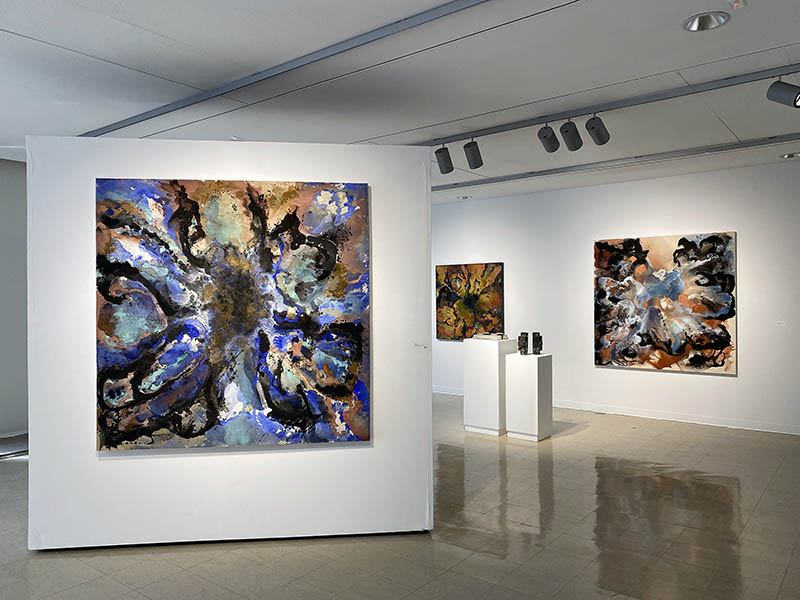
Creating an Identity
This year, the gallery staff hired MFA student in Graphic Design, Taylor Gamlin, to create a graphic identity for Aggregrate and to produce postcards, posters, and wall text. Gamlin explains that, as a fellow graduate student, her personal connections with the students helped her develop a highly professional identity design that felt cohesive but also expressive to each of the three artists in the show. “The title is about a collection of parts that don't seem like they fit together,” says Gamlin. “Ephemera draws their A’s as triangles — their natural handwriting. I was really drawn to this triangle, because it made me think about the fact that there were three artists showing as a trifecta.” Gamlin built from this starting point, experimenting with typefaces that could elevate the idea and create a strong visual identity. She also played with the idea of aggregates in nature. “Together, the work feels like a collection of elements: iron for Aaron’s work, pigment for Sarah’s, and pills for Ephemera,” says Gamlin. “Focusing on elements made it easy for me to figure out where to go with the poster and the postcard.”
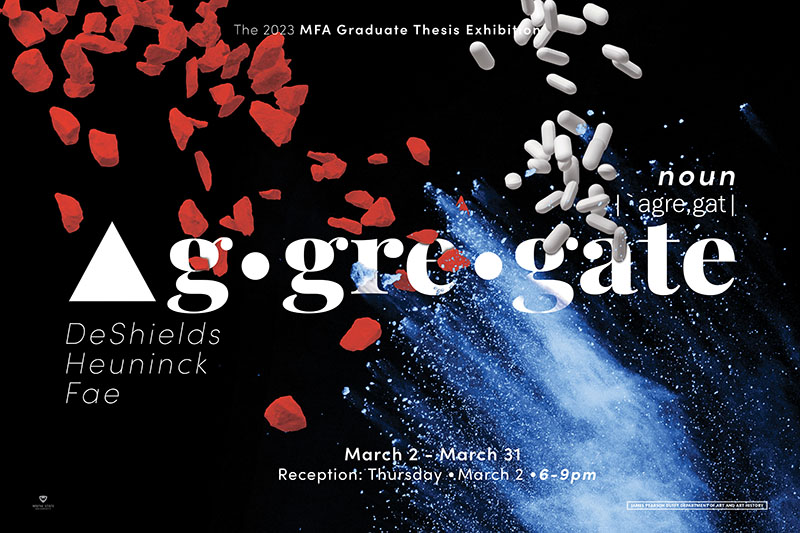
MFA Exhibition: Aggregrate
Pyrzewski and Makar feel strongly that the MFA Exhibition is a helpful launching point for many students,reaching new audiences for their work. “The exhibition gives students access to a highly professional space for networking and hosting meetings,” says Pyrzewski. “Their work is hung so well and well lit, and there is a flow and a presence to their work. The Art Department Gallery is a professional gallery, and we take every detail seriously. We want students to know and feel that.”
Organization, planning, and collaboration are critical to the success of the show. “What made this year unique was that the students were really well organized,” says Makar. “The students had their vision of how they wanted their work to be displayed, and they chose the right amount. They didn't overpack it. They worked closely together, and they’re very supportive of each other. There is a lot of camaraderie. They know that they have to do the program together and without each other they won’t succeed. The show is an extension of that experience.”
Getting the word out is another critical aspect of making the MFA shows a success. Pyrzewski says that attendance grows each year, and they have seen a steady increase in interest from collectors looking for emerging artists. “With the opening reception and during gallery hours, the students make an effort to meet with curators and directors,” says Makar. “This helps them to establish new professional relationships, to network, and arrange studio visits.” Students have met with representatives from the Detroit Museum of Contemporary Art, M Contemporary Art, Live Coal Gallery, Wasserman Projects, Galerie Camille, The Carr Center, Reyes | Finn, Scarab Club, and Detroit Artists Market.
This year, Sarah Heuninck sold two pieces to local private collectors. “The collectors invited me over to see their collection and that was thrilling. I had never seen anything like it. It was great to see people interested in my work, and to then see my work as part of this great private collection,” Sarah says. Unlike a commercial gallery, the Art Department Gallery is a non-profit. When artists make a sale, the gallery does not take a commission.
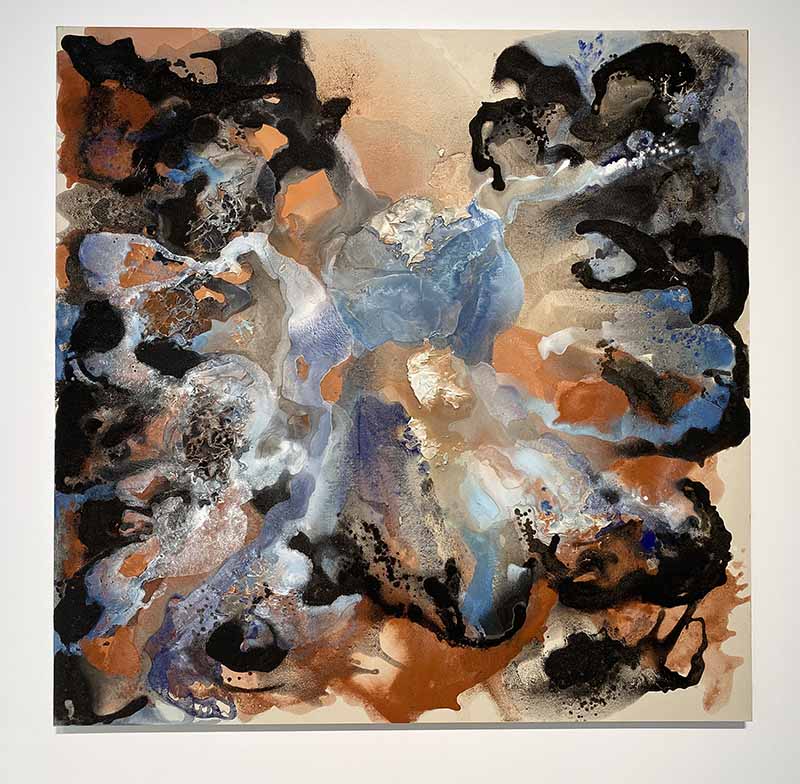
Graduating Seniors Exhibition: Genesis
Unlike the MFA Exhibition that is planned throughout the year, the Graduating Seniors Exhibition comes together within a much shorter timeline and with many more students displaying work. The exhibition presents a challenge to balance a large number of submissions with the size of the space while maintaining the high standards of the gallery. The Art Department Gallery typically holds up to 65 works, but for this show, Makar says, they usually have 200 works on display from undergraduates.
The intention behind the Graduating Seniors show is also very different. “The purpose is more of a year-end celebration to feature the best work from all of the disciplines,” says Pyrzewski. He adds, “So many people attend. We get friends and families, but we also get collectors and gallery directors.” Some years there are scholarship awards distributed, and usually other special programming, such as music and a reception.
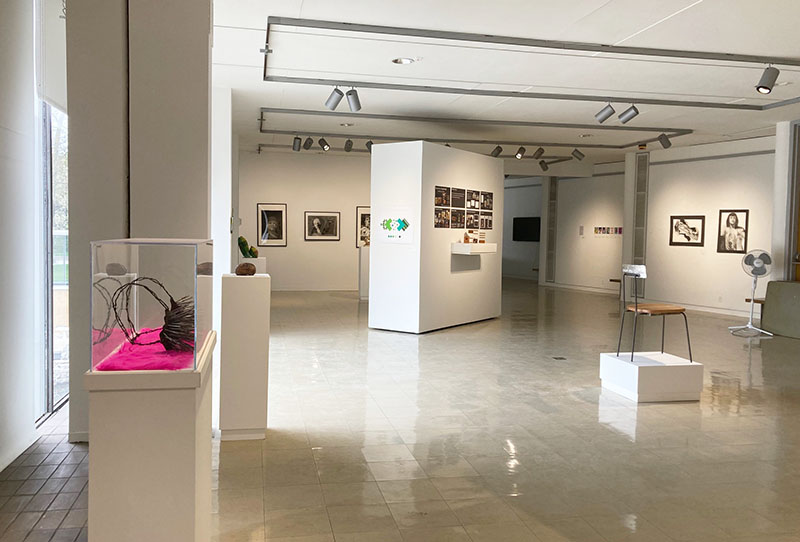
As the coordinator of a Gallery Learning Community, and teacher for the Art Gallery Management courses, ACS 5200 and 5210, Pyrzewski uses this exhibition to engage undergraduate students with a hands-on learning experience. Each year, the Gallery Learning Community serves as co-coordinators of the exhibition, developing the name, promotional materials, and all text accompanying the show. The students learn all steps of organizing a show, from layout to installation. They utilize demos recently prepared by Pyrzewski and Makar that include directions on how to properly measure, hang, light, prepare surfaces, and mount text.
This year, Taylor Gamlin also worked with the undergraduate students to develop with exhibition identity. The students decided on the word Genesis, which, according to Gamlin, is meant to reflect different realities coming together to form something new. “They wanted it to be very ethereal and other-world-like, and they liked the idea of mixing space with nature,” she says. “I knew that the text needed to feel bigger than it actually is, so I played with the idea of distortion — elongating and expanding and then squeezing and shrinking. I wanted this to really seize the attention of the viewer — to feel engulfing, bold, loud, and brave, something that suggests diving into new realities and expanding upon itself.
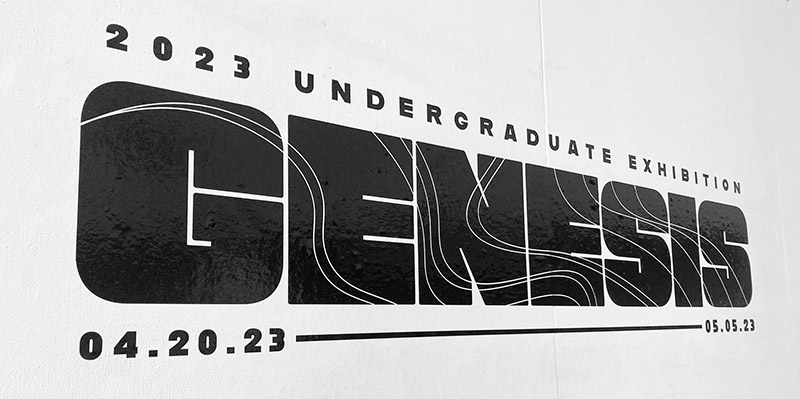
Virtual Impact
After hosting virtual exhibitions during the pandemic, the gallery staff feel strongly about the impact of being back on campus and open to the public. “I feel like last year we were back, but this year we are really back,” says Pyrzewski. “This year feels like our first normal season since the pandemic. The turnout at the opening, the exposure, and attendance throughout the duration of the show was great. Since we are back on campus, the students are taking advantage of the space to network and bring people there to see their work, to promote themselves, and connect to other galleries and collectors.”
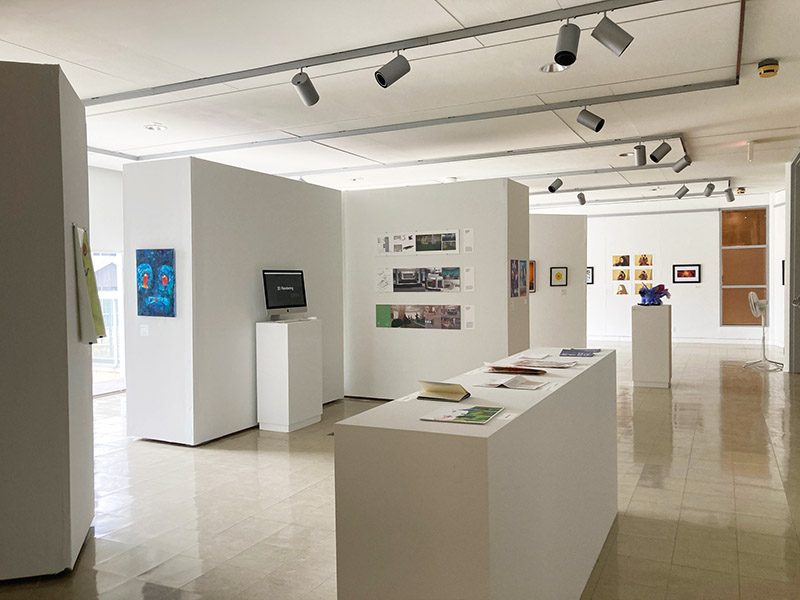
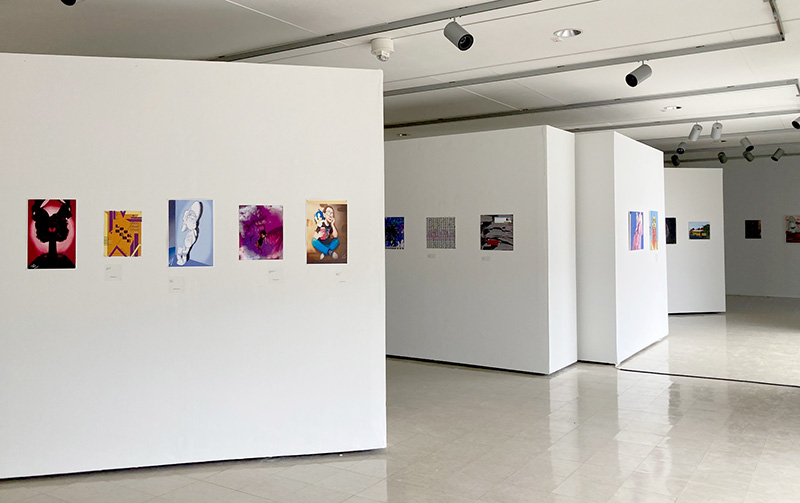
During Covid, Instagram and the gallery website helped to maintain and build traffic to the shows. Makar says, “I am seeing more connectedness with our followers, especially through our weekly postings about the artists.” Social media has also been a great way to say “thank you.”. “I think that it is very important to show appreciation to the people who come to the shows and support our programming. We try to do something to boost excitement while the show is up, finding ways to engage followers so they come back a second time or a third time, or so that they can participate virtually. For example, we Instagram Lived a recent gallery performance, and it blew up. We probably never would have thought to do that before.”
Ultimately, the galleries are also reaching people well beyond Detroit. “The mission for both of the galleries is an educational experience for students from everywhere, not just WSU,” says Pyrzewski. “We are really seeing the positive experience that their students can gain from looking at our exhibitions online. The beauty of the galleries going virtual is that they allow people across the world to connect and see the shows and see what’s going on. We have so much more international interaction, lately with Australia, Germany, the Netherlands. With the Elaine Jacob Gallery, it’s no longer about just bringing an international artist to Detroit. It’s bringing the international audience to Detroit artists.”